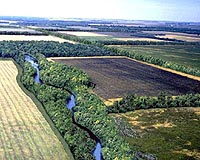| . |  |
. |
Sydney (AFP) May 22, 2009 Australia's Tasmanian devil, the world's largest surviving marsupial carnivore, will be listed as endangered because of a contagious and deadly cancer, the government said Friday. "This disease has led to the decline of about 70 percent of the Tasmanian devil population since the disease was first reported in 1996," Environment Minister Peter Garrett said in a statement. Devil facial tumour disease, which is spread through biting, kills the animals usually within three months by growing over their faces and mouths, preventing them from eating. Early European settlers named the feisty marsupial the devil for its spine-chilling screeches, dark appearance and reputed bad temper which, along with its steeltrap jaw, made it appear incredibly fierce. The animals were previously listed as vulnerable, and Garrett said the change in status to endangered would give them greater protection under national environment law. "Fortunately, strong action is being taken to find out more about this disease and to stop its spread," he said. The government had committed 10 million dollars (7.5 million US) over five years to a program aimed at saving the devil, including research into the disease and support for captive and wild populations, he said. The species is restricted to the island state of Tasmania after competition from the dingo led to its extinction on mainland Australia. It is Australia's largest marsupial carnivore after the extinction last century of its distant cousin, the thylacine or Tasmanian tiger. Share This Article With Planet Earth
Related Links Darwin Today At TerraDaily.com
 Beneficial Plant Spillover Effect Seen From Landscape Corridors
Beneficial Plant Spillover Effect Seen From Landscape CorridorsRaleigh NC (SPX) May 22, 2009 Research by a North Carolina State University biologist and colleagues shows that using landscape corridors, the "superhighways" that connect isolated patches of habitat, to protect certain plants has a large "spillover" effect that increases the number of plant species outside the conservation area. The study found that corridors caused such a wide range of "spillover" beyond the patches ... read more |
|
| The content herein, unless otherwise known to be public domain, are Copyright 1995-2009 - SpaceDaily. AFP and UPI Wire Stories are copyright Agence France-Presse and United Press International. ESA Portal Reports are copyright European Space Agency. All NASA sourced material is public domain. Additional copyrights may apply in whole or part to other bona fide parties. Advertising does not imply endorsement,agreement or approval of any opinions, statements or information provided by SpaceDaily on any Web page published or hosted by SpaceDaily. Privacy Statement |